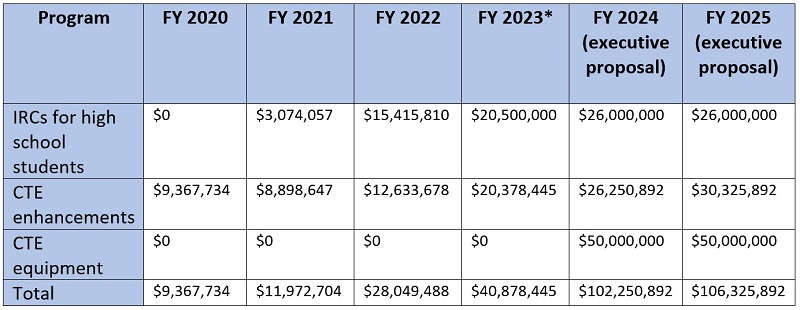The Ohio Senate recently introduced its version of the state budget for fiscal years 2024 and 2025. The upper chamber maintained several proposals that were introduced by Governor DeWine and passed by the House, including increased funding and expanded eligibility for school choice programs and provisions aimed at ensuring that elementary schools are using instructional methods and materials aligned with the science of reading. The Senate also deserves praise for removing some troubling additions made by the House, namely a provision that would eliminate the third grade retention requirement.
Overall, the Senate deserves plenty of kudos for its budget proposal. But not everything included in their version is praiseworthy. Specifically, the upper chamber took an axe to some proposed career-technical education (CTE) funding increases, dollars that could have improved and expanded opportunities for thousands of students across the state.
To understand these cuts in context, some background is needed. When Governor DeWine released his budget recommendations in January, it was immediately obvious that he intended to double down on his commitment to expanding and improving CTE in Ohio. He proposed boosting funding in three specific areas:
- Industry Recognized Credentials (IRCs) for high school students. The state has been investing funds in IRCs for high schoolers since DeWine’s first budget, which established the Innovative Workforce Incentive Program. This program provides grant funding to school districts to help them establish programs for students to earn qualifying credentials in “priority” industry sectors. To incentivize attainment, schools also receive an additional payment of $1,250 when students earn a qualifying credential.
- CTE enhancements. ODE identifies a host of potential program enhancements that fall under the CTE umbrella. They include—but aren’t limited to—things like apprenticeships, work-based learning, credit flexibility, and Career Connections.
- CTE equipment. Unlike math and English classes, which are typically taught in traditional classrooms with textbooks and Chromebooks and the like, CTE courses often require much different settings and materials. For example, the state’s engineering and science technologies and manufacturing technologies career field prepares students for college majors like engineering and robotics and/or a career as a welder, machinist, or line operator. Students need to master various competencies—essential skills—like cutting and drilling materials, splicing and terminating cables and wires, and constructing “a digital circuit based on schematics using solder and solderless techniques.” Teaching students to do these things requires a variety of tools and equipment that are expensive, and CTE providers need help from the state to afford them. Governor DeWine specifically mentioned in his state of the state address that, while visiting career centers across Ohio, he recognized that many lack the “modern, up-to-date equipment needed to teach certain courses.”
As the table below shows, CTE spending in these three areas has risen consistently during DeWine’s time as governor. His latest budget, which covers FY 2024 and 2025, proposes the state’s largest investments yet.

When House lawmakers passed their version of the budget in April, they maintained DeWine’s proposed funding amounts for IRCs for high school students, as well as for CTE equipment. And in the area of CTE enhancements, they actually increased the dollar amount by roughly $2 million for both FY 2024 and 2025.
These significant boosts in funding indicate that CTE holds the same priority for the lower chamber as it does for the governor. The Senate, on the other hand, opted to trim some of the increases proposed by their colleagues. Consider the table below, which shows the dollar amount that each of the three major players in the budget process—the governor, the House, and the Senate—proposed for each of the aforementioned CTE areas according to the most recent appropriation spreadsheet.
The most obvious takeaway from the table above is that although the governor and the House proposed $50 million in each fiscal year to cover the cost of CTE equipment, the Senate did not—at least not in this particular part of the budget. It appears they included the funds for CTE equipment as an earmark in the Ohio Facilities Construction Commission budget instead, but they did so without increasing the overall dollar amount. That means they will likely cut CTE construction funding relative to the governor’s original proposal.

But that’s not the only example of the Senate being tight-fisted when it comes to CTE. Both the governor and the House proposed raising IRC funding to $26 million in FY 2024 and 2025—an increase of roughly $6 million from the estimated FY 2023 funding amount. The Senate, on the other hand, proposed reducing funding to $16 million, which would represent a decrease of approximately $4.5 million from the FY 2023 amount. The CTE enhancements category follows a similar pattern. The governor proposed boosting funding to just over $26 million in FY 2024 and slightly more than $30 million in FY 2025. The House took it a step further, and raised the governor’s proposed appropriation by roughly $2 million for each year. But the Senate kiboshed these increases by proposing fewer dollars for FY 2024, and then offering a modest increase for FY 2025. Although it’s not included in the table above, the governor also proposed—and the House maintained—up to $10 million in each fiscal year for a Work-based Learning Incentive Program that would require the Ohio Department of Education to pay public schools $1,000 for each student participating in at least 250 hours of work-based learning. The Senate eliminated that provision, too.
When considering dollar amounts in this way, it’s important to remember that budgeting is about give and take. If policymakers want to boost funding for certain programs, then that typically means that others will face cuts. The protests and praise that result from such decisions are part and parcel of the budget process, and lawmakers are likely accustomed to hearing complaints. Tuning them out is only natural.
But in the case of CTE, Ohio lawmakers would be wise to listen carefully. IRCs can lead to well-paying jobs, identify qualified job applicants for employers, and contribute to a healthy statewide economy. Ohio’s credentialing efforts are far from perfect, but there’s no denying that they’ve created opportunities for thousands of high schoolers. They’re also part of the state’s graduation requirements. There are plenty of ways lawmakers could and should improve the system, and some of those improvements will require increased funding.
CTE enhancements, meanwhile, fund delivery methods, practical learning opportunities, and student supports that can bolster career pathways programs. Such programs can be a promising option for young adults, as they’re typically more affordable than a traditional four-year university. They also offer myriad benefits—including on-the-job learning experience and job-related classroom training, boosted income, and valuable industry-recognized credentials.
Budgeting is a tough job. Everyone wants more money, and money doesn’t grow on trees. But as the Senate puts its finishing touches on its version of the budget and then gets ready for possible conference committee debates, lawmakers would be wise to remember just how important CTE programs are to students, employers, and Ohio at large. Funding them properly is crucial.




